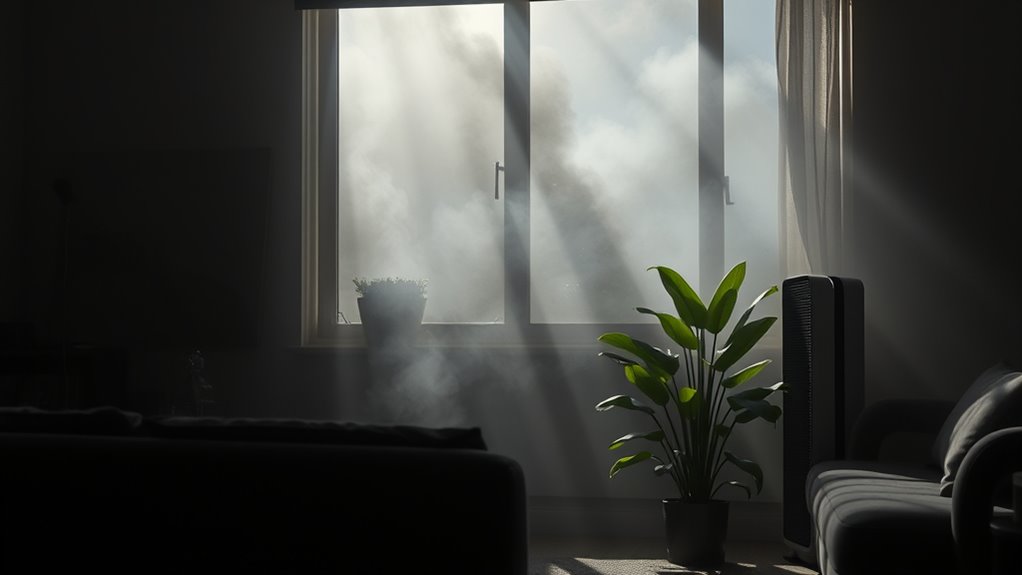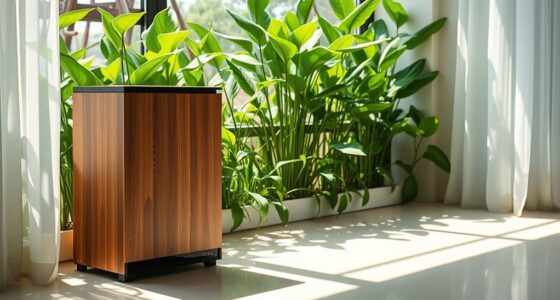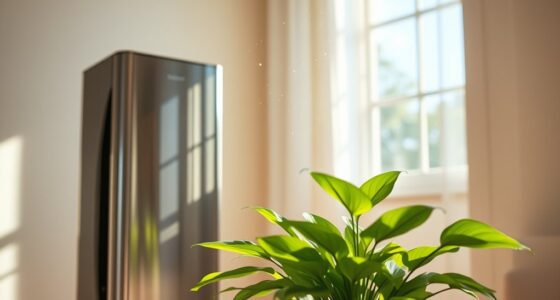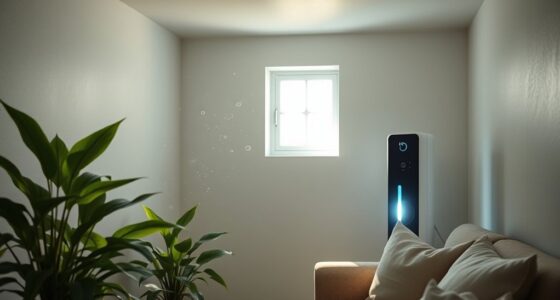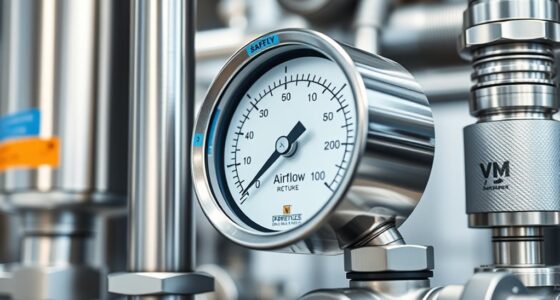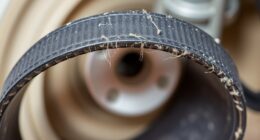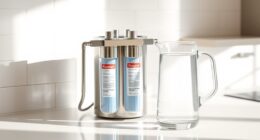If wildfire smoke invades your home, air purifiers can be your best defense against harmful pollutants. Choose HEPA-filtered purifiers with MERV 13 ratings to effectively capture PM2.5 particles. Keep doors and windows closed to limit smoke entry, and consider a DIY air purifier like the Corsi-Rosenthal Box for an affordable option. Regularly assess your indoor air quality to stay safe and healthy. Discover more strategies to protect your home from smoke and improve air quality.
Key Takeaways
- Invest in HEPA-filtered air purifiers to effectively capture PM2.5 particles from wildfire smoke, improving indoor air quality significantly.
- Check the CADR ratings for smoke on air purifiers to ensure optimal performance during wildfire events.
- Seal windows and doors to prevent smoke from entering your home while using air purifiers for better results.
- Regularly monitor indoor air quality with real-time data from air quality monitors to gauge PM2.5 levels.
- Create a DIY air purifier using a box fan and MERV-13 filters as a cost-effective alternative to commercial devices.
Understanding the Health Risks of Wildfire Smoke
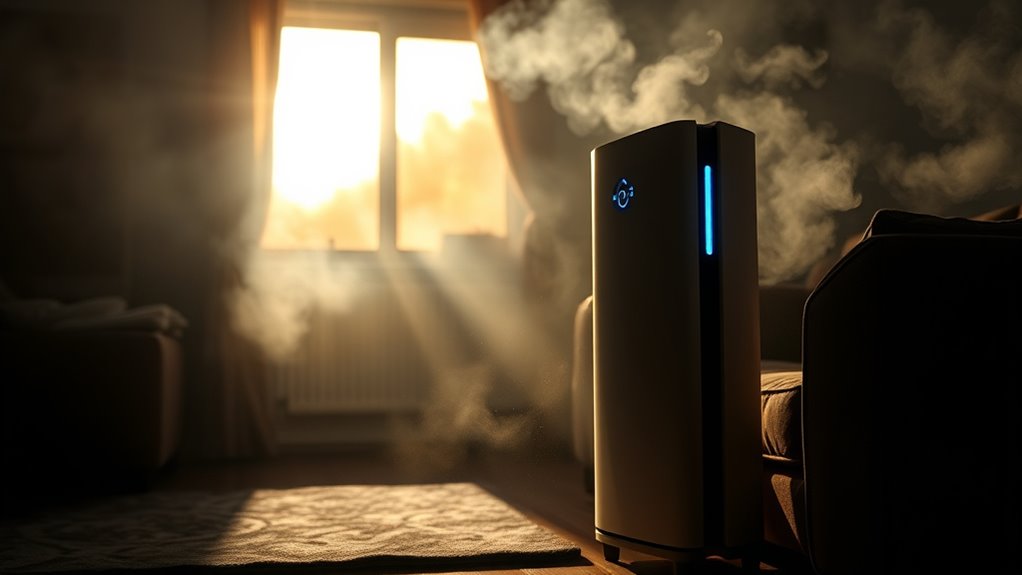
Wildfire smoke poses serious health risks that you shouldn’t ignore. This smoke contains fine particulate matter (PM2.5), which is 30 times smaller than human hair and can easily infiltrate your lungs and bloodstream.
The EPA warns that PM2.5 can lead to significant health issues, including respiratory problems and cardiovascular diseases. If you’re in an underserved community, you might face even higher exposure, worsening existing health disparities. Additionally, air purifiers with HEPA filters are specifically designed to effectively capture these harmful particles, helping to mitigate the risks associated with wildfire smoke. It’s essential to choose models such as the Winix 5500-2 Air Purifier, known for its effectiveness in capturing airborne pollutants. Regular maintenance is crucial to ensure that air purifiers function optimally during wildfire events.
Prolonged exposure can increase the likelihood of lung diseases, heart attacks, and strokes, especially for vulnerable populations like children and the elderly. Symptoms such as coughing, wheezing, and eye irritation highlight the urgent need for effective air quality solutions. Additionally, using an air purifier with HEPA filtration can significantly reduce harmful particles in your home, providing a safer environment during wildfire events. Regularly checking and cleaning filters can enhance the performance of your air purifier during these critical times.
Staying informed about these risks will help you protect your health during wildfire events.
How to Assess Your Indoor Air Quality

To assess your indoor air quality, start by checking the Air Quality Index (AQI) to understand the outdoor conditions.
Next, monitor indoor particulate levels, especially PM2.5, to gauge any potential risks. Regular maintenance of your air purifier, including filter cleaning and replacement, can significantly enhance its effectiveness during wildfire events. Additionally, consider investing in a device with HEPA filters to ensure maximum air purification efficiency. Choosing a model with smart home integration can also enhance monitoring capabilities and ease of use. Finally, evaluate how effectively your air purifier is cleaning the air, ensuring it meets your needs during wildfire events. Regular use of air purifiers can lead to improved respiratory health and alleviate symptoms of asthma and allergies.
Understanding Air Quality Index
Understanding the Air Quality Index (AQI) is essential for evaluating your indoor air quality, especially when outdoor pollution levels rise.
The AQI measures the concentration of pollutants like smoke particles and assigns a value ranging from “Good” to “Hazardous.” When the AQI exceeds 150, it’s considered “Unhealthy,” which can impact everyone’s health. For sensitive groups, an AQI between 101-150 signals potential risks. Natural Language Processing can also play a role in analyzing public sentiment regarding air quality, providing insights into community concerns. Additionally, understanding airless paint sprayers can help in enhancing indoor environments by enabling easier maintenance and improvements to air quality. You can stay informed by checking the EPA’s AirNow.gov for real-time data on local air quality. Moreover, monitoring the Air Quality Index in your area can help you take timely measures to protect your health.
To protect your indoor air quality during high AQI levels, keep windows and doors closed and use air purifiers equipped with HEPA filters. This way, you can minimize the impact of outdoor pollution inside your home. Additionally, monitoring dietary intake can help reduce the effects of poor air quality on your overall health.
Monitoring Indoor Particulates
Here are some effective ways to monitor indoor particulates:
- Use air quality monitors to get real-time data on fine particulate matter (PM2.5) levels.
- Regularly check apps or websites like AirNow.gov for updates on your indoor air quality.
- Pay attention to the Air Quality Index (AQI) to gauge overall air quality.
- Invest in air purifiers equipped with HEPA filters to remove harmful particles. Additionally, consider how energy efficiency ratings can impact the effectiveness of your air purifiers.
- Make a habit of evaluating your environment when smoke levels rise. Consistent maintenance of your air purifiers is crucial for optimal performance during these times.
Evaluating Air Purifier Effectiveness
Evaluating the effectiveness of your air purifier is vital for guaranteeing a healthy indoor environment, especially during wildfire season. Regularly monitor the Air Quality Index (AQI) for real-time data on smoke levels. Look for air purifiers with the AHAM Verifide® Mark and check their Clean Air Delivery Rate (CADR) ratings for smoke. Using HEPA filters rated MERV 13 or higher is essential for capturing harmful PM2.5 particles. Conduct periodic assessments to measure PM2.5 and PM10 concentrations in your home. Additionally, freshly squeezed juices can help boost your immune system, aiding in recovery from smoke exposure. Maintaining a clean and dry environment is also crucial, as it helps reduce the presence of allergens that can complicate smoke-related respiratory issues. Regular home cleaning supports a healthier lifestyle by promoting cleanliness and hygiene, further enhancing your indoor air quality. Implementing hydration strategies can also support your overall health during smoke events. Furthermore, understanding air quality standards helps ensure that the measures you take are effective and aligned with health recommendations.
| Action | Importance |
|---|---|
| Monitor AQI | Keeps you informed about air quality |
| Check CADR ratings | Guarantees effective smoke reduction |
| Use MERV 13 HEPA filters | Captures fine particulate matter |
| Replace filters regularly | Maintains purifier effectiveness |
| Conduct air quality assessments | Validates indoor air quality |
Effective Air Purification Solutions for Wildfire Smoke
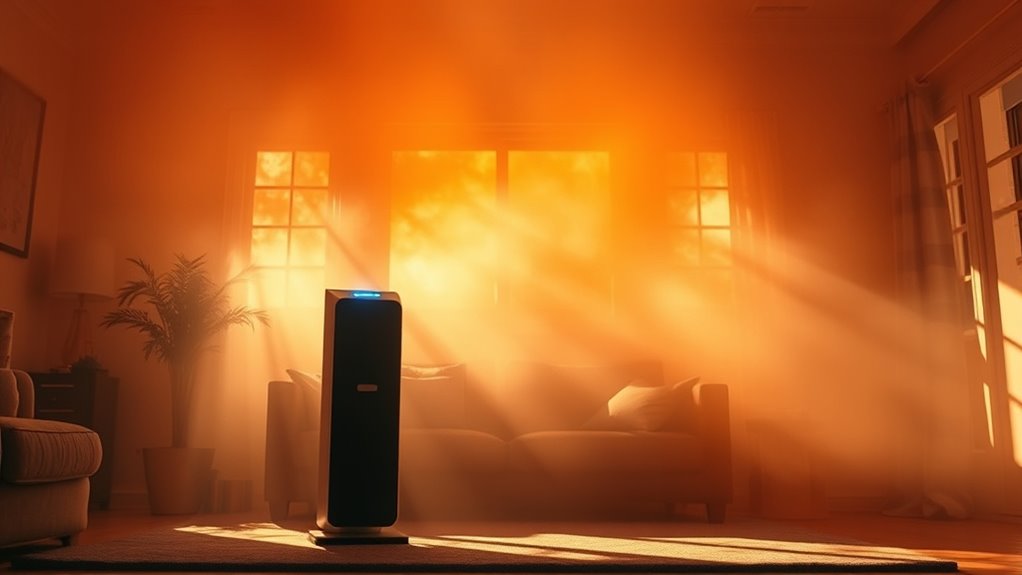
When wildfire smoke infiltrates your home, effective air purification becomes essential to maintaining a healthy indoor environment.
Effective air purification is vital for preserving a healthy indoor environment when wildfire smoke enters your home.
You can choose from several solutions to combat harmful particles and improve air quality:
- True HEPA air purifiers like Coway AP-1512HH and Blueair Blue Pure 211i Max remove particles smaller than 10 microns.
- Corsi-Rosenthal Box: A DIY air cleaner that combines a box fan with MERV-13 filters, reducing PM2.5 concentrations considerably.
- Air purifiers with CADR specifically for smoke should match your room size for ideal performance.
- Upgrade HVAC filters to MERV 13-rated filters to enhance filtration of fine particulates.
- Portable air purifiers provide immediate relief for those with respiratory issues during high smoke conditions.
Investing in these solutions can safeguard your indoor air quality.
DIY Air Purifier: A Cost-Effective Solution
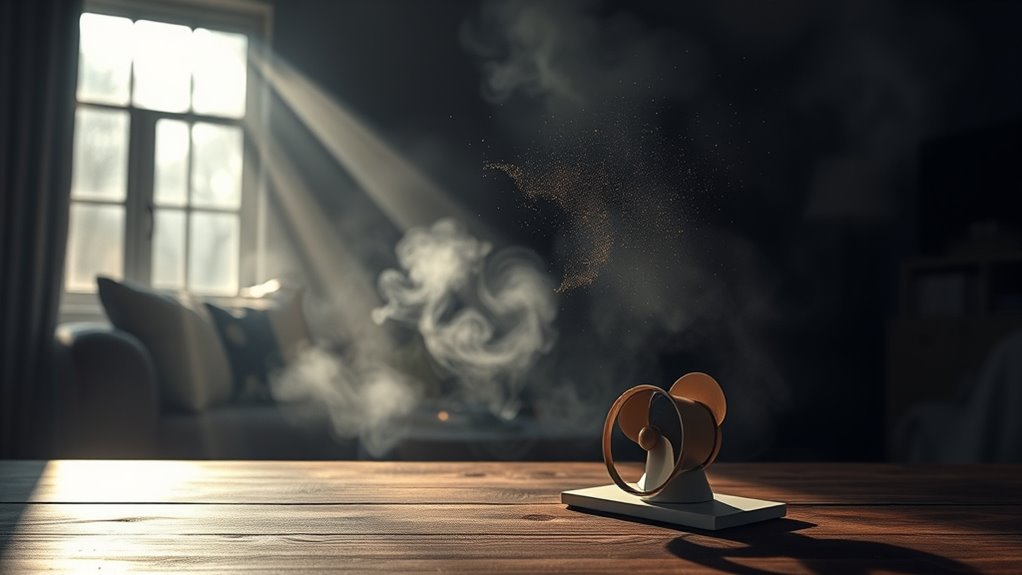
Creating a DIY air purifier can be an effective and budget-friendly way to tackle the challenges posed by wildfire smoke. The Corsi-Rosenthal Box, made with a 20-inch box fan and four MERV-13 rated filters, costs around $85 and provides cleaner indoor air.
This portable air solution pulls in contaminated air through the filters and releases purified air from the top, reducing PM2.5 levels by over 43% in tested spaces like classrooms. Unlike traditional HEPA filters, these components maintain performance longer, making the DIY air purifier a sustainable choice.
Plus, with common materials like cardboard, scissors, and duct tape, you can easily construct it, promoting community-driven efforts to improve air quality.
Upgrading Your HVAC System for Better Air Quality
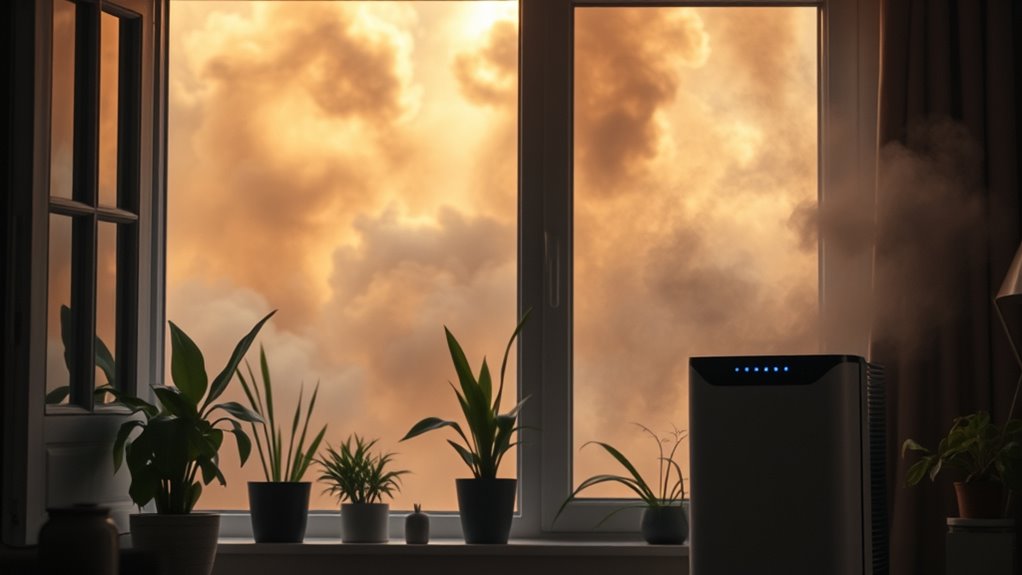
Upgrading your HVAC system can greatly improve your indoor air quality, especially during wildfire season.
Consider these essential steps:
- Install MERV 13-rated filters to capture fine wildfire smoke particles.
- Regularly replace your HVAC filters, especially after heavy smoke exposure.
- Modify older HVAC systems to accommodate higher-rated filters if needed.
- Supplement your system with portable air purifiers for enhanced filtration.
- Check the California Air Resources Board for certified indoor cleaning devices suitable for your needs.
Keeping Smoke Out: Home Containment Strategies
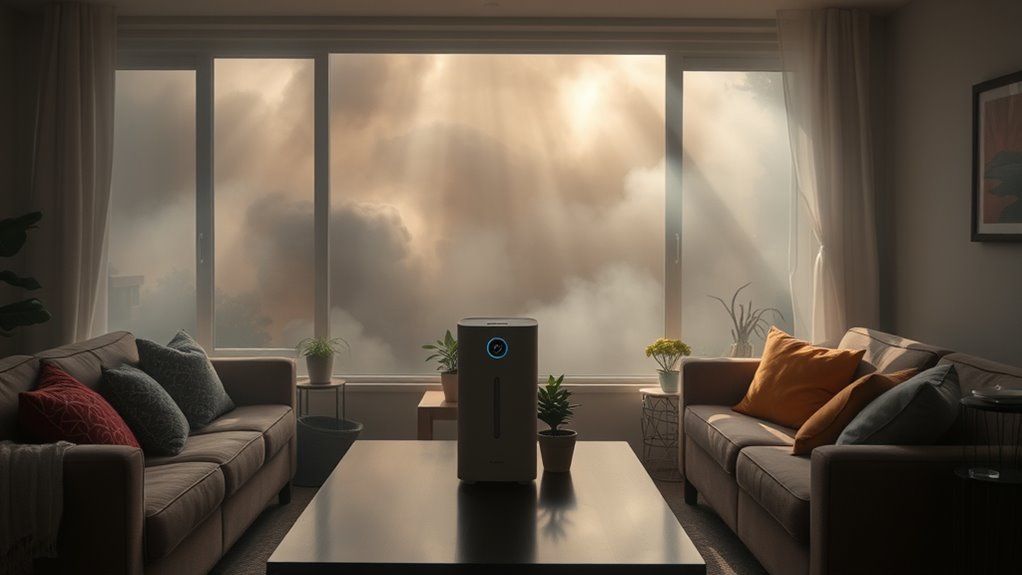
Improving your HVAC system is just one part of the equation for maintaining a smoke-free home during wildfire season. To effectively keep smoke out, close all windows and exterior doors, as even brief openings can lead to significant smoke infiltration. Use weather sealing tape to seal drafty windows and employ draft stoppers or door sweeps to block gaps under doors. Regularly check these barriers to guarantee they maintain their integrity and protect your indoor air quality.
| Strategy | Purpose | Tools Needed |
|---|---|---|
| Close Windows | Prevent smoke entry | N/A |
| Use Weather Sealing | Seal gaps around windows | Frost King Weatherseal |
| Install Draft Stoppers | Block gaps under doors | Door sweeps or draft stoppers |
| Regular Maintenance | Guarantee effectiveness | Visual inspections |
Maintaining a Clean Indoor Environment
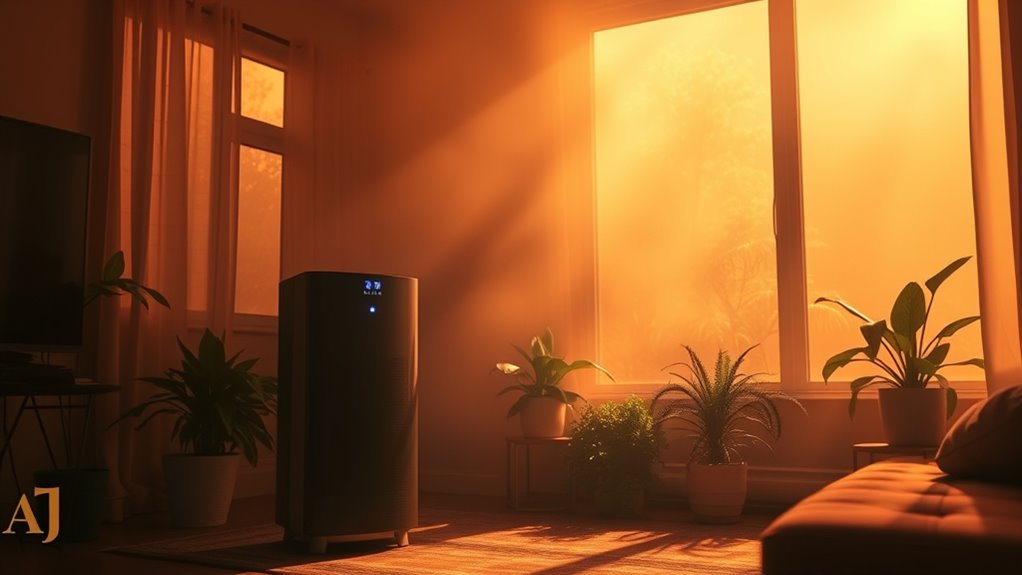
As wildfire smoke infiltrates your home, maintaining a clean indoor environment becomes essential for your health and comfort.
To guarantee clean air and improve air quality inside, follow these tips:
- Regularly damp-mop floors to capture settled smoke particles.
- Change clothes immediately after being outdoors to minimize pollutants.
- Take quick showers before bedtime to wash off smoke residue.
- Frequently clean all surfaces and change air filters to remove trapped microscopic particles.
- Implement a consistent cleaning routine, including washing sheets more often.
The Impact of Poor Air Quality on Pets
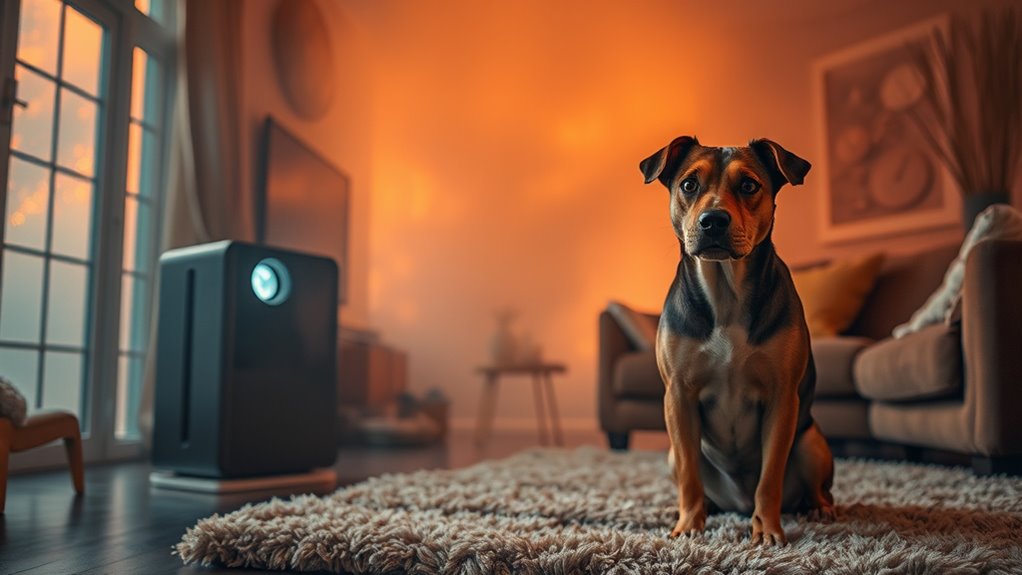
When wildfire smoke fills the air, it’s not just humans who suffer; our pets can be equally affected by poor air quality.
Pets can develop respiratory symptoms like coughing, difficulty breathing, and eye irritation, especially when the air quality index (AQI) exceeds 151. High-risk pets, including brachycephalic breeds, puppies, kittens, and seniors, are particularly vulnerable to unhealthy air quality.
Birds are also at risk and should stay indoors during high particulate levels. Smoke contains harmful PM2.5 particles that can penetrate deep into their lungs and bloodstream, leading to long-term health issues.
It’s essential to monitor your pet’s health during these times, as signs of distress may indicate significant exposure to hazardous pollutants.
Preparing Your Home for Future Wildfire Events
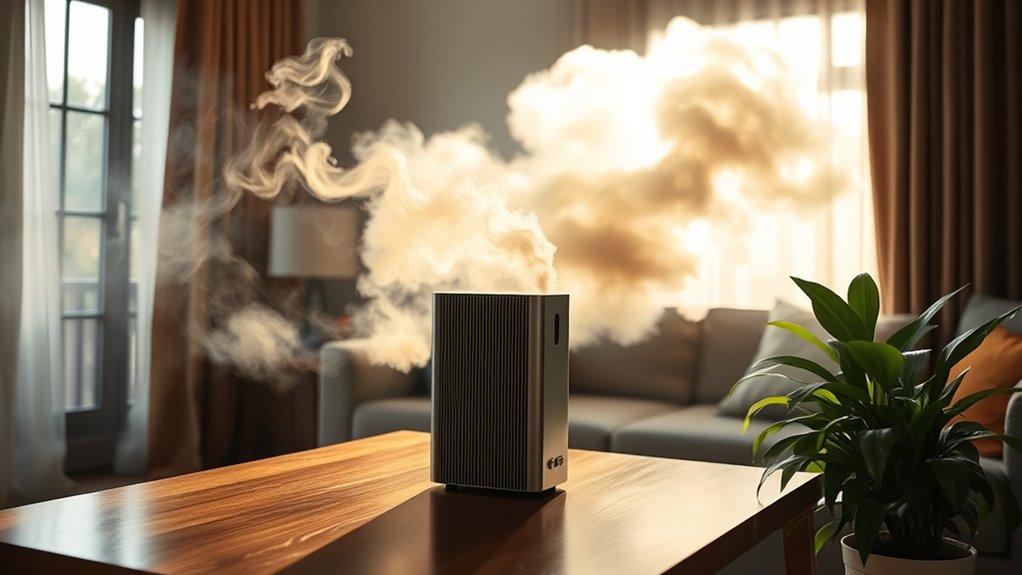
Preparing your home for future wildfire events involves taking proactive steps to safeguard your indoor air quality. Here are some essential actions you can take:
- Invest in a DIY Corsi-Rosenthal box air purifier to markedly reduce PM2.5 and PM10 concentrations.
- Upgrade your HVAC system with MERV 13-rated filters to effectively capture fine particulates.
- Seal drafty windows and doors using weather sealing tape and door sweeps to prevent smoke infiltration.
- Keep windows and doors closed when the Air Quality Index (AQI) exceeds 151 to limit outdoor smoke exposure.
- Regularly monitor local air quality through resources like AirNow.gov for timely updates.
Frequently Asked Questions
Will Air Purifiers Help With Wildfire Smoke?
Yes, air purifiers can help with wildfire smoke. They’re designed to filter out harmful particles, including PM2.5, which is prevalent in smoke.
When you use a true HEPA air purifier or a DIY Corsi-Rosenthal Box, you’ll notice a significant improvement in air quality.
Just remember to change the filters regularly and use high airflow settings for the best results. Your home can feel safer and more breathable during smoky conditions.
How to Purify Air From Fire Smoke?
To purify air from fire smoke, start by using an air purifier with a True-HEPA filter; it captures tiny particles, including harmful PM2.5.
You can also build a Corsi-Rosenthal Box with a box fan and MERV-13 filters for a cost-effective solution.
Keep your windows and doors shut during high smoke events, and regularly change your filters to maintain performance.
Finally, monitor your indoor air quality to guarantee effective purification.
Do Air Purifiers Help With Bushfire Smoke?
Yes, air purifiers can help with bushfire smoke. They’re designed to capture harmful particles, including PM2.5, which are prevalent in smoke.
When you choose a purifier with a True HEPA filter and an appropriate Clean Air Delivery Rate (CADR) for your space, you’ll notice significant improvements in air quality.
Running it continuously, especially on high settings, quickly clears smoke-filled air, providing you immediate relief from indoor air pollution during fire events.
How Do You Clean a House After a Wildfire Smoke?
Cleaning your house after wildfire smoke can feel like battling a dragon.
First, ventilate your space and use HEPA air purifiers to tackle lingering particles.
Instead of vacuuming, damp-mop hard surfaces to keep settled smoke from swirling back into the air.
Wash all fabrics and seal gaps in windows and doors to block more smoke.
Upgrade your HVAC filters to MERV 13 and monitor your air quality to guarantee it’s safe again.
Conclusion
As wildfire smoke creeps into your home, it’s easy to feel overwhelmed by the immediate threat to your health. Yet, with the right air purifiers and proactive strategies, you can transform your living space into a safe haven. By investing in effective solutions today, you’re not just combating the current crisis; you’re also preparing for future challenges. Your home can be a refuge, turning the chaos of wildfire smoke into an opportunity for better air quality and peace of mind.
